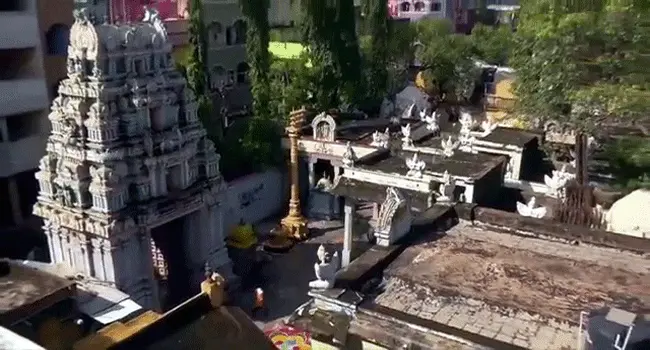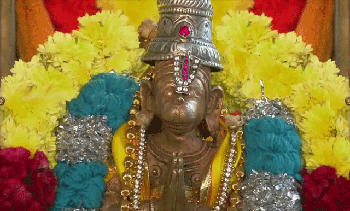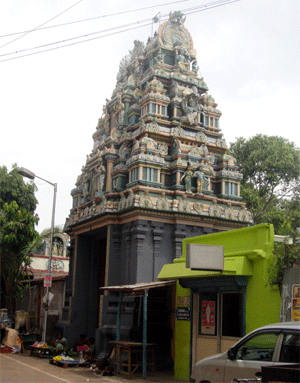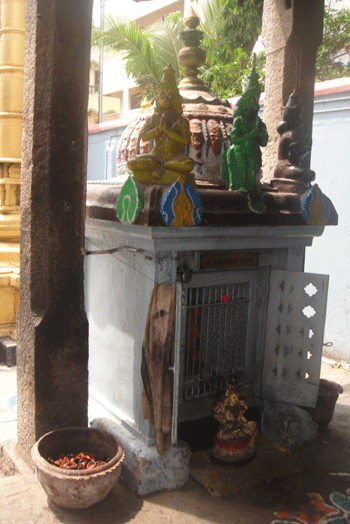
British establishment of Madras
Portuguese, and Dutch, were there in India and trading. They had a strong presence in Machilipatnam when the British came onto the scene. Muslin clothes and other textiles were the main trading commodity for the Europeans. British wanted to shift their base from Machilipatnam port city and went on the lookout for a suitable place along the Coromandel Coast during the second decade of the seventeenth century.
Initially, they established a trading centre at Armagon (Dugarazpatnam), a village some 35 miles north of Pulicat. Not satisfied with the present site for the factory and trading, the chief of the factory Francis Day, one of the officers of the East India Company, and a member of the Masulipatam Council, made a voyage of exploration in 1637 down the coast as far as Pondicherry to choose a site for a new settlement.
The Portuguese used Pulicat as a port for trading with the help of Vijayanagar rulers. They also had port operations in San Thome on the Mylapore coast from as early first decade of the sixteenth century. Therefore British zeroed down a place for their operations in between these two places.
On 22 August 1639, the British-owned English East India Company under Francis Day bought a small strip of land stretching three miles on the Coromandel Coast. They got a license to build a fort and a castle in the contracted region. The ruler Damarla Chennappa Nayakudu, the Nayak representative of the Chandragiri ruler, granted permission to the English to build a factory and a warehouse for their trading enterprises. The region was then primarily a fishing village known as ‘Madraspatnam’ or ‘Madrascoopam’.
New settlers from Andhra
 Four villages namely Madrascoopam where the E.I.C. built a fort, Chennaicoopam, Arcoopam, and Maleput were the villages that were brought/ leased by East India Company to begin with.
Four villages namely Madrascoopam where the E.I.C. built a fort, Chennaicoopam, Arcoopam, and Maleput were the villages that were brought/ leased by East India Company to begin with.
The labour force of these four villages was not sufficient for their factory which had a huge task of supplying textiles to the company for export.
Therefore the company headquarters at Machillipatnam had taken pains to send people from their known destinations of present Andhra for resettlement at Madraspatnam. Looking at all the resettlements in old Madras, many of them were weavers, washers, bleachers, and merchants of textiles only.
As the years progressed the town of Madraspatnam had to grow and so the EIC bought more land and created a ‘black town’ closer to the Fort and created new settlements there. At a later stage when the company grew big and they needed more people, they created a ‘new black town’, an area that was about eight times bigger than the ‘black town’. Apart from the four names of the villages mentioned in the record, the name of the villages where ‘black town’ or ‘new black town’ [Old city] had grown is not known, at least the names of the villages are not seen in the public domain. By new black town or Old City I mean the harbor on the east, West Wall Road [Mint Street] in the west, Old Jail Road in the north, and NSC Bose Road in the south. This vast area must have had many villages that have lost their identity to be known by a new name. Muthialpet, mannadi, seven wells, and Sowkarpet are fairly new names.
The old town walls
 English were trying to strengthen their hold on Chennai and they were facing threats from the French and the Mysore Sultanate. Hence they thought of fortifying the entire Chennai town by building walls on all three sides with the fourth side already protected by sea. Before the wall was built, Tippu Sultan raided the city in 1767 and Haider Ali in 1769. Water supply from the Seven Wells, the Government House, and the St. Thomas Mount had come under threat then. These raids hastened the English to take up the project of building the wall for the town immediately.
English were trying to strengthen their hold on Chennai and they were facing threats from the French and the Mysore Sultanate. Hence they thought of fortifying the entire Chennai town by building walls on all three sides with the fourth side already protected by sea. Before the wall was built, Tippu Sultan raided the city in 1767 and Haider Ali in 1769. Water supply from the Seven Wells, the Government House, and the St. Thomas Mount had come under threat then. These raids hastened the English to take up the project of building the wall for the town immediately.
They had built the northern wall with four entry points, Boatmen Gate, Pully Gate, Tiruvatore Gate, and Ennore Gate, and completed the wall by the end of 1769. In today’s scenario, this wall would have run along the present old jail road.
Barrack Street, Seven wells
Barrack Street in the Seven Wells area is a road that runs parallel to Old Jail Road, but not for the full length. It starts at the Portuguese Church Street and ends at the Seven-wells Street. When coming from Church Street on the right side a huge compound wall will be there throughout the distance till one reaches Sri Hanuman Temple. But on the left side, several streets are running perpendicular to this street. One of the streets just opposite the temple namely Verasamy Street is where Sri Aurulprakasa Sri Ramalinga Adigalar had lived.
The huge area between Old Jail Road and Barrack Street is now being used as an extension and hostel for Stanley Medical Hospital and College. Practically Sri Hanuman temple is the first structure to be found on the right side of this road.
The origin of worship goes back to the mid-18th century when soldiers of different formations were stationed here including those from present-day Karnataka, Andhra, and Maharashtra. Soldiers were carrying Sri Hanuman in Yantra itself and carrying on with their puja to the deity.
Pala Kurichchi
This whole area in those days was inflicted with battle and war. Soldiers had been camping in this area. Earlier whoever wanted to attack Madras must have come through this place only. Later when the British built their protective wall their soldiers must have been stationed here. It might be the reason why this road got the name ‘Barrack Street’. The huge area between Old Jail Road and Barrack Street, presently where the extension and hostel for Stanley Medical Hospital and Collage are must have been a barrack for the armed men. Locals say the area is known as ‘Pala Kurichchi’ from old times. In Tamil Kurichchi or Kurinjchi is referred to a place adjacent to a hill. It is not understood as to why this place should be called by the name Pala Kurichchi.
Barrack Road Sri Anjaneya temple
A temple for Sri Anjaneya is present on Barrack Road. Why? After entering the huge temple complex, one could find the sannidhi for Sri Rama on the left side. The complex has sannidhis for Sri Renukkambal, Ramanujar, Ranganathar-Andal, Esanya Ganapati, Sastha, and other deities. There is a small sannidhi for Sri Anjaneya just opposite Sri Rama sannidhi. Sri Aurulprakasa Sri Ramalinga Adigalar had sung in praise of Sri Rama of this temple. This great saint had lived near this temple from the early 19th century. Therefore it is believed that Sri Rama sannidhi of this temple is a minimum of two hundred years old.
Legend
 Although this temple is called Sri Anjaneya temple, today many more big sannidhis are found for other deities. When enquired about sannidhi for Sri Anjaneya, we were told that Lord is Yantra pradeshta here and worshipped inside Sri Rama sannidhi itself. The Lord’s Yantra is covered with ‘sinduram’ as was the practice of the good old days of soldiers.
Although this temple is called Sri Anjaneya temple, today many more big sannidhis are found for other deities. When enquired about sannidhi for Sri Anjaneya, we were told that Lord is Yantra pradeshta here and worshipped inside Sri Rama sannidhi itself. The Lord’s Yantra is covered with ‘sinduram’ as was the practice of the good old days of soldiers.
The origin of worship goes back to the mid-18th century when soldiers of different formations were stationed here including those from present-day Karnataka, Andhra, and Maharashtra. It is well known that soldiers get inspiration from worshipping Sakti in the form of Kali or Sri Anjaneya as Veera Hanuman. During the period in question, worship of Sri Hanuman was in practice. Soldiers were carrying Sri Hanuman in Yantra itself and carrying on with their puja to the deity.
Yantra is a mystical diagram, mainly from the Tantric traditions which is used for the worship of deities in temples as well as at home - as an aid in meditation; used for the benefits given by their occult powers. Even today the deities in the temple are installed on the Yantra specially prepared for the specific deity. It is generally believed that the Yantra itself gives power to the deity who is installed on it.
It is also said that the soldiers were worshipping Kalikamba here during that time. Today the Kalikamba worshipped by them is known as Renukambal and is in worship here in this complex.
Sri Rama along with Sitadevi and Lakshmanan had been installed more than about two hundred years back within the proximity of Sri Hanuman who is present in the Yantra form.
Other Sannidhis
Huge well built three tiers Rajagopuram welcomes the devotees. The complex is surrounded by lots of trees on all sides, making the atmosphere pleasant, pleasing, and conducive to meditation. As one enters the temple through the Rajagopuram there is a sannidhi on the left for Sri Rama parivar. Just opposite to this sannidhi is a small sannidhi for Sri Anjaneya. Behind this sannidhi is a pipal tree under which a ‘naga pradishta’ had been done. North-west corner has a sannidhi for Sri Renukambal. Next to this, there is a sannidhi for Sri Ranganathar along with Sri Andal as found in Srivalliputtur. In the Eshana corner, there is a sannidhi for Sri Vinayaka. Next to this, there is a sannidhi for Sri Ayyappa. There is sannidhi also for Sri Ramanujacharya.
Location of the temple: "Sri Anjaneya Swamy Temple, Seven Wells, George Town, Chennai"
Experience
Ubiquitous Hanuman in Yantra and the presence of Sri Rama, Sita, and Lakshmana worshipped by many pundits for centuries is boundlessly happy in this kshetra and waits to bestow all ‘bhadram’- happiness and fortune in full to all His devotees.
SRI HANUMAN THINKS DIFFERENTLY, THINKS FAST
THINKS AHEAD AND ACTS FOR SURE
Ed [September 2017]
Updates: [Jan 2025]
